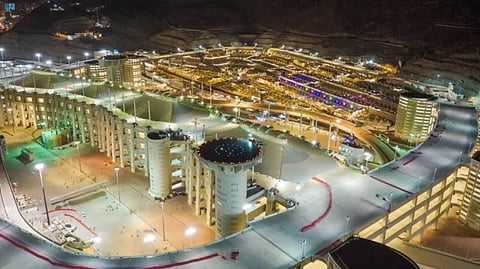Hajj 2025: Pilgrims start flocking to Mina from Mecca early morning today
Saudi authorities have ramped up preparations to protect pilgrims’ health and wellbeing

Dubai: Pilgrims began streaming into Mina early today from their residences in Mecca to observe the Day of Tarwiyah, marking the official start of the annual Hajj pilgrimage.
Following the tradition of Prophet Muhammad (PBUH), they chanted the Talbiyah — “Here I am, O God, here I am. You have no partner, here I am” — as they made their way to Mina, famously known as the Tent City.
This year, over 1.47 million international pilgrims are joined by hundreds of thousands of domestic pilgrims in one of the world’s largest religious gatherings.
Nestled in a valley five kilometres east of the Grand Mosque in Mecca, Mina is a key waypoint in the Hajj journey. Its iconic landscape of over 100,000 fire-resistant white tents is designed to accommodate more than 2.6 million pilgrims, offering essential amenities to ensure safety, comfort, and dignity during the sacred rites. Mina’s infrastructure stands as a feat of modern logistics and engineering. A complex network of roads, tunnels, and bridges facilitates smooth movement between the three principal Hajj sites: Mina, Arafat, and Muzdalifah — showcasing both spiritual harmony and organisational precision.
Dr. Mohammed Al Qarni, Director General of Hajj and Umrah at the General Transportation Centre of the Royal Commission for Mecca City and the Holy Sites, said that transportation from Mina to Arafat — the next stage of the pilgrimage — will commence using three modes: the Mashair train will transport 316,000 pilgrims, while traditional and multi-modal systems will carry an estimated 720,000 more.
Meanwhile, Al Khayf Mosque in Mina has been fully prepared to welcome worshippers, with prayer rugs spread across 27,000 square meters. The mosque has undergone major upgrades, including advanced air-conditioning systems linked to smart controls, CO₂ sensors, and automated cooling systems to maximise comfort in the summer heat.
With soaring temperatures expected, Saudi authorities have ramped up preparations to protect pilgrims’ health and wellbeing. Dr. Abdullah Asir, Deputy Minister of Health, announced the deployment of 50,000 medical and administrative personnel — the largest contingent in Hajj history. Over 700 hospital beds have been designated for treating heat-related illnesses, supported by three field hospitals and 71 emergency response points. Ministry spokesman Eng. Khaled Al Tala’a confirmed that the pilgrims’ health remains stable, and that healthcare capacity has increased by 60% compared to last year. More than 98,000 medical services have already been delivered.
As Hajj unfolds, the Kingdom’s meticulous preparations underscore its commitment to ensuring a safe, seamless, and spiritually uplifting experience for all pilgrims.
Sign up for the Daily Briefing
Get the latest news and updates straight to your inbox



